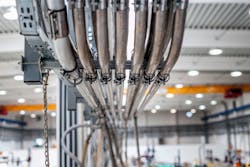A 3-inch stainless steel vortex shedding flowmeter is sized to measure a maximum water flow of 100 gallons per minute (gpm) full scale. Can this flowmeter measure the desired 10-gpm minimum flow required for startup?
Vortex shedding flowmeters have four common constraints: materials of construction, available size, Reynolds number and velocity. The availability of the 3-inch size and its stainless steel construction are not issues in this application.
The Reynolds number associated with a water flow of 100 gpm in a 3-inch pipe is (3160 x 100 x 1) / (1 x 3), or approximately 100,000. Vortex shedding flowmeters operate above Reynolds numbers of 10,000 to 40,000 depending on manufacturer and size. Details should be considered, but most 3-inch vortex shedders will not operate properly at 10 gpm with a Reynolds number of approximately 10,000.
In a 3-inch pipe, 100 gpm flows at approximately 4.4 feet per second, so the velocity at 10 gpm is approximately 0.44 feet per second. This relatively low velocity will cause a problem because vortex shedding typically ceases below approximately 1 foot per second in liquids.
In summary, the Reynolds number constraint may or may not be violated in this particular 3-inch vortex shedding flowmeter. However, this flowmeter will not measure the desired flow of 10 gpm because it will turn off and cease to operate below approximately 20 to 25 gpm.
Additional complicating factors
Using a 2-inch vortex shedding flowmeter would increase the velocities at 100 and 10 gpm to 9.74 and 0.97 feet per second, respectively. This will increase the Reynolds number and should increase the velocity sufficiently to allow the 2-inch flowmeter to measure a flow of 10 gpm.
David W. Spitzer is a regular contributor to Flow Control magazine and a principal in Spitzer and Boyes LLC offering engineering; seminars; strategic marketing consulting; distribution consulting; and expert witness services for manufacturing and automation companies. Spitzer and Boyes is also the publisher of the Industrial Automation INSIDER. Spitzer has more than 40 years of experience and has written more than 10 books and 300 articles about flow measurement, instrumentation and process control. He may be reached at 845-623-1830 or at spitzerandboyes.com.


